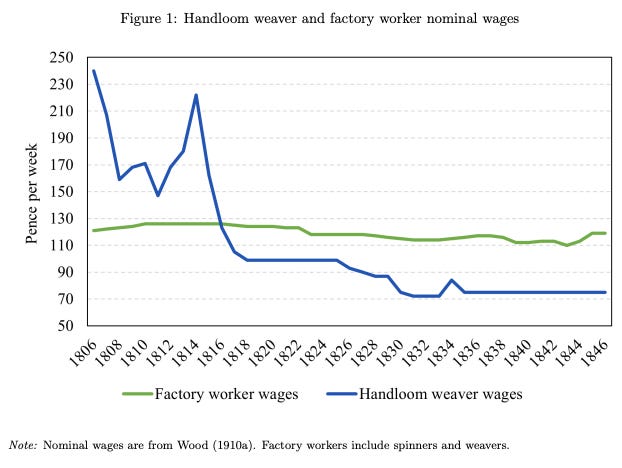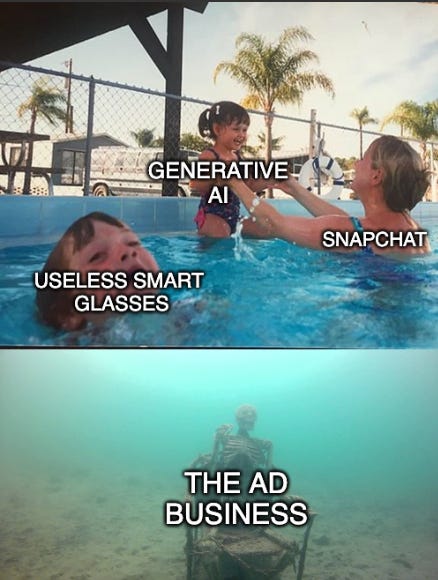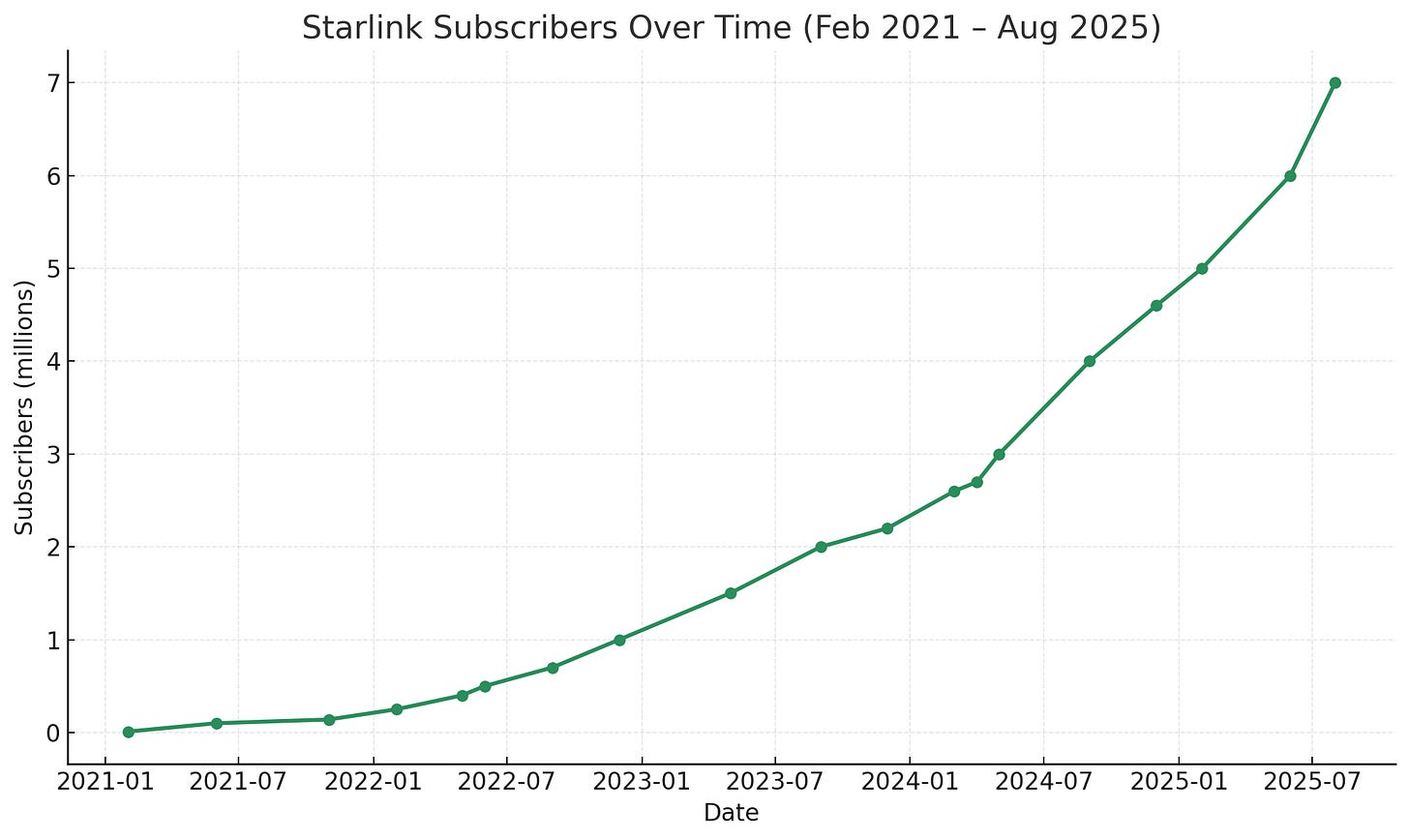What Happens When Amazon Replaces Its Workforce with Robots?
The Weekend Leverage, October 26th
Writing this edition of The Weekend Leverage, I couldn’t help but cackle in delight. There is so much science and startup energy in the world right now. Dreams keep getting bigger, founders keep getting more ambitious. Some sick part of me is just thrilled by it all. Here’s to the crazy ones! If you are building something stupid ambitious reach out.
This edition we’ll cover:
What the future of software looks like
Starlink’s 10,000th satellite
My favorite long-form article of the year
Whether you can build a movie studio with AI and 60 second TikTok clips
MY RESEARCH
AI apps are coming for it all. It used to be in software that you wanted customers to swap your product in as a replacement for someone else. With AI, the goal is now to make the previous generation of SaaS entirely irrelevant. EliseAI is the furthest along that journey I’ve seen. They charge a traditional SaaS license for their AI products and then bundle in more traditional software applications like a CRM for free. A really remarkable company that I think every software company should be studying closely.
What’s the bet: Sublime. We should want tools that use the latest technology to make things that weren’t possible before. Sublime is one of the few startups I’ve seen actually doing that noble goal in personal knowledge management software. Most software systems rely on a filing or tagging system to organize themselves. Sublime uses LLMs and embeddings to organize your files on the basis of “vibes.” The company has built an incredibly loyal customer base with 79% annual retention rates and is now trying to figure out growth. A worthy product to investigate to see a vision for a very different future for knowledge work.
WHAT MATTERED THIS WEEK?
PUBLICS
Amazon plans to replace 500,000+ jobs with robots. This week, the New York Times got their hands on an internal strategy document from the Amazon robotics team. In it, they argue that they can “flatten Amazon’s hiring curve over the next 10 years” by automating over “75 percent of their operations.” This seems to be net good to me? Assembling cardboard boxes is demeaning labor and if we can automate it away, all the better. As always with technological improvements, the question to me isn’t whether this getting rid of these jobs is good or not, (obviously we would prefer no one wears out their body in service of 2 hour deliveries) but what happens to the people working these jobs?
You can look at the Luddites for an example here. In the early 1800s British textile industry, Handloom weavers held skilled, well-compensated roles. However, mechanization allowed factories to produce the same product at lower costs and higher volumes. Wages quickly collapsed.
Mechanization did what it promised: productivity and output surged, costs fell, and consumers benefited. But the workers directly displaced by the new machines didn’t magically ascend to higher living standards. Their nominal wages collapsed even as factory workers’ pay held steady. In other words, the liberation of labor from drudgery didn’t translate into prosperity for the liberated. It took decades—and often a complete change in occupation or geography—for those families to regain the income they lost. Automation freed people from work, but not from scarcity. The same held true in the Rust Belt with the loss of US manufacturing to globalization and the same will be true of these Amazon workers.
If you think populism and economic rage is bad now, give it a decade.
Snap plans a spinoff. According to friend of the publication @sources, Snap is planning to move its augmented reality glasses into a separate subsidiary and raise outside capital from investors, including Saudi Arabia’s sovereign wealth fund. The stated goal is to free up internal resources for generative AI initiatives. But this is a company fundamentally afflicted by shiny object syndrome. Before chasing the next big thing, they need to fix their ad attribution—an argument I’ve been making since 2022. The meme I created in 2023 is, unfortunately, relevant once again.
AI LABS
The revenue incest will continue until margins improve. Anthropic and Google announced a partnership worth “tens of billions of dollars” to give Anthropic access to about 1 gigawatt, or roughly 50 billion dollars worth, of datacenter that Google has built. This is notable because Amazon is their “primary cloud partner” and obtained this status with about $8 billion invested into the company. Again, Anthropic and OpenAI are two of the fastest growing companies of all time, and these investments are justified, but the degree of economic entanglement between big tech and the leading research labs is notable.
OpenAI joins the browser wars. Their long-rumored browser launched this week with a feature set that is roughly on par with Perplexity’s Comet and Dia from The Browser Company. All of these firms are employing a similar feature set, a similar product strategy, and offer a similar level of utility. Personally, I’ve churned off the AI browsers. The security risks are really, really extreme and we currently have no real answers to solving them. Additionally, these things just aren’t that useful (yet). AI agents are not generalizable enough to actually use a browser consistently and error free. The only AI agents products that work are ones that operate in highly-structured environments like Vertical SaaS applications or coding.
LAUNCHES
SpaceX just launched its 10,000 Starlink satellite. Amazon’s Project Kuiper has 153. The hardware gap alone is probably insurmountable, but what’s more interesting is how subscriber acquisition is accelerating. I pulled every article I could find with user counts, and the growth curve is exponential.
And the product actually works. I took a 13-hour flight to Hawaii two months ago with Starlink onboard, and it genuinely made the whole thing bearable. High-speed internet at 35,000 feet is legitimately magical when you’re using it.
But here’s where the strategy gets really interesting. SpaceX just acquired wireless spectrum licenses from EchoStar for $17 billion, which means they’re not stopping at satellite internet. They’re going after direct-to-cell coverage anywhere in the world, positioning themselves as a legitimate competitor to carriers like Verizon and AT&T.
The structural advantage is what makes this so hard to counter. SpaceX owns the rocket company, which means every competitor has to pay someone else to launch their satellites while SpaceX just... doesn’t. It’s the kind of vertical integration moat that compounds over decades, creating cost advantages that become harder to overcome with each passing year.
The game might not be technically over, but it’s increasingly difficult to see how anyone closes this gap.
DEAL VIBES
Do you want to watch TV made by AI? Our current media environment is akin to going to Home Depot and gently sticking your tongue into a variety of power sockets. Every 60 seconds another jolt, another dollop of dopamine administered via a new short-form video. Traditional media companies are woefully unprepared to compete in this world because production costs are usually too high to justify investing in the volume that vertical video requires. Plus, the large cost savings that AI can offer are considered no bueno. This leaves an obvious gap in the market for startups to compete.
As previously discussed in this newsletter, even when AI can give obvious cost savings or competitive advantages, that does not mean it is obvious what type of company should be built. There were three venture capital deals announced this week in media that exemplify this:
Vertically integrated operator: The thesis is simple—AI nukes content production costs, so own the whole stack and pocket the difference. Wonder Studios raised $12 million to become an AI-native movie studio and “accelerate a push into IP ownership and original content production” in VC-speak. The catch is that they’re not building models. They’re just users of everyone else’s infra, betting they can arbitrage margin before the rest of Hollywood figures out the same playbook.
Picks and shovels: If you think media is a shit business even with 10x better margins, sell the infrastructure instead. Fal.ai raised $250 million at a $4 billion valuation doing exactly this—providing the plumbing for multi-modal models (image gen, video gen, the whole suite). Again, they’re not training models. They’re just the middleware. The bet is that being a toll booth is better than being a content producer, even in an AI world.
Betting on the downstream effects: AI makes content cheaper and it rewires how we consume it. Years of TikTok and algorithm-driven feeds have trained us to expect everything in bite-sized bursts, and that behavioral shift is what GammaTime is actually betting on with their $14 million raise announced this week. They’re producing “microdramas”—90-minute programs chopped into dozens of short clips—where the first few pieces get distributed free on social platforms to hook viewers, then the rest sits behind a paywall. The format has already proven massive in China, and GammaTime’s thesis is that Western audiences have been conditioned the same way, they just haven’t had the content designed for it yet. Sure, they’re using AI to make production cheaper like Wonder Studios (their URL even has the .ai moniker, because of course it does), but the real play is recognizing that recommendation algorithms have fundamentally altered what people can even pay attention to anymore, and building a media company native to that new reality.
All of these founders are foolish of course. What the people really want is deeply researched 3,000 word essays on technology delivered to their email inbox. It’s the future! Right guys? Right?
TASTEMAKER
Reject the slop. Two highly recommended essays and two apps this week:
The Goon Squad by Daniel Kolitz: Continuing our themes on the evolution of media, this article’s writer embeds himself within what amounts to a pornography-addicted, Discord and Reddit organized, sex cult. This group is comprised of Gen Z men that will have extended masturbation sessions, many hours long, aimed at achieving a supposed state of ego death or bliss called the “goonstate.” They almost exclusively watch short-form videos compiled together with a thumping beat underneath. This is fascinating in and of itself, but the writing is incredibly well done. Please indulge me in an extended quote,
“You can read a book, pet a dog, buy a stupid box to lock away your phone. You can make a joke about the box, about the absurdity of your need for it. What do these companies care? They’ve won. If they have their way—and they usually do—in time we will all be gooners, of a kind.
This isn’t to suggest that we aren’t enthusiastic collaborators in the progressive annihilation of our brains. Nor is it to suggest that, absent attention-shattering social platforms, we’d use the internet solely to keep up with friends and engage in improving hobbies. Peering into Goonworld’s darkest corners has convinced me that what we are dealing with here may well be a structural flaw of networked communication itself. Is there a timeline, a regulatory environment, in which the internet does not turn into a highly efficient manufacturer of niche suicide cults? I find it hard to imagine.”
The Vulgar Image by Dean Kissick: We’ve optimized ourselves into aesthetic oblivion—everyone has the same perfect face, the same curated coffee shop, the same boring good taste—and AI is our way out through the sewer. This essay argues that the explosion of AI-generated monsters flooding Instagram (hairless swimming cats with old Chinese women’s heads, flayed salmon-men eating themselves, raccoon goblins getting sponge baths) represents a new folk art that’s deliberately vulgar, illegible, and fake because beauty has become suffocating and meaningless. This article made me consider how AI fundamentally rewires our relationship with the human body, disgust, and authenticity. When you can’t shock people with sex anymore (because porn is infinite), when every image is already fake (because we’re all filtered avatars), the only way to feel something is through grotesque AI chimeras that make us uncomfortable in new ways.
Lossless audio on Spotify and Idagio: You should hear music the way it was meant to be—uncompressed. Whenever we use bluetooth, we smush the audio range of a piece of music, leaving it flat, emotionless, and tinny. My two favorite music apps, Spotify for popular music and Idagio for classical music, now offer lossless audio. I’ve spent the week relistening to albums that I thought I knew well. Every time I’ve been impressed with subtle details that I hadn’t heard before. Highly recommend listening to Marvin Gaye’s beautiful tenor voice sing across What’s Going On.
Have a great week,
Evan
Sponsorships
We are now accepting sponsors for the winter. If you are interested in reaching my audience of 35K+ founders, investors, and senior tech executives, send me an email at team@gettheleverage.com.










What a great rundown!
Since you’re a fan of lossless audio, please tell us about what kit you’re using to listen to it!